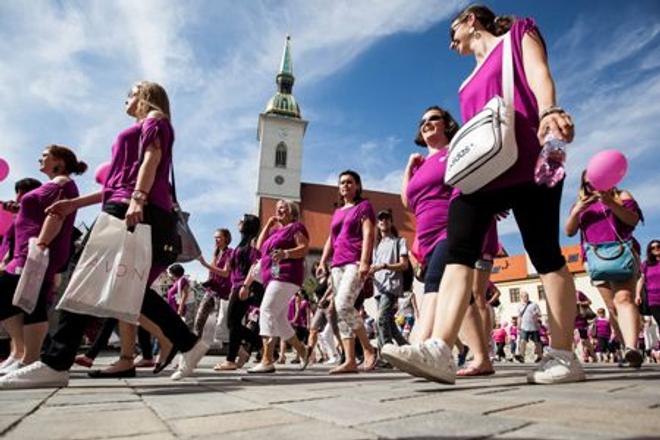THOUSANDS of women in pink T-shirts marched through downtown Bratislava on June 15, the fifth annual event in the Slovak capital to draw attention to breast cancer and raise money for more screening and treatment. A record number of 4,500 people participated in the Avon pochod (Avon march).
The march started near Eurovea shopping centre and followed majorettes and a percussionist from the Capana Batucada group along the Danube embankment, through the historical city centre and Michalská Street and then back to Eurovea. The goal was to draw attention to the issue of breast cancer and to collect money for its prevention and treatment. A total of €64,196 was donated and €46,596 was earmarked for the Oncology Institute of St Elisabeth Hospital in Bratislava for a diagnostic and treatment device called Intact BLES. The remaining €17,600 will be used by the League Against Cancer for its projects and activities fighting breast cancer.
Several famous Slovak celebrities and showbiz people took part in the march, such as actor Maroš Kramár, singer Beáta Dubovská, presenter Ada Straková – and also the “face” of this year’s Avon march, TV host Kveta Horváthová.
“Only 35 percent of women in Slovakia visit a gynaecology department where breasts are examined too, and only 22 to 25 percent of women over 40 go to regular preventive mammography checks,” stated Vladimír Bella, the chief doctor of the Mammography Department of the Oncology Institute of St Elisabeth’s, to the TASR newswire. “Women either feel they have no time for that, or fear the diagnosis itself, or downplay the problem. We have more advanced stages of the cancer being diagnosed,” Bella added. He recommended that women should start examining their breasts when they are age 18 (once every three months) and should continue on a monthly basis after age 25 as well as have a gynaecological exam once a year and a mammographic exam every two years.



 (source: SITA )
(source: SITA )